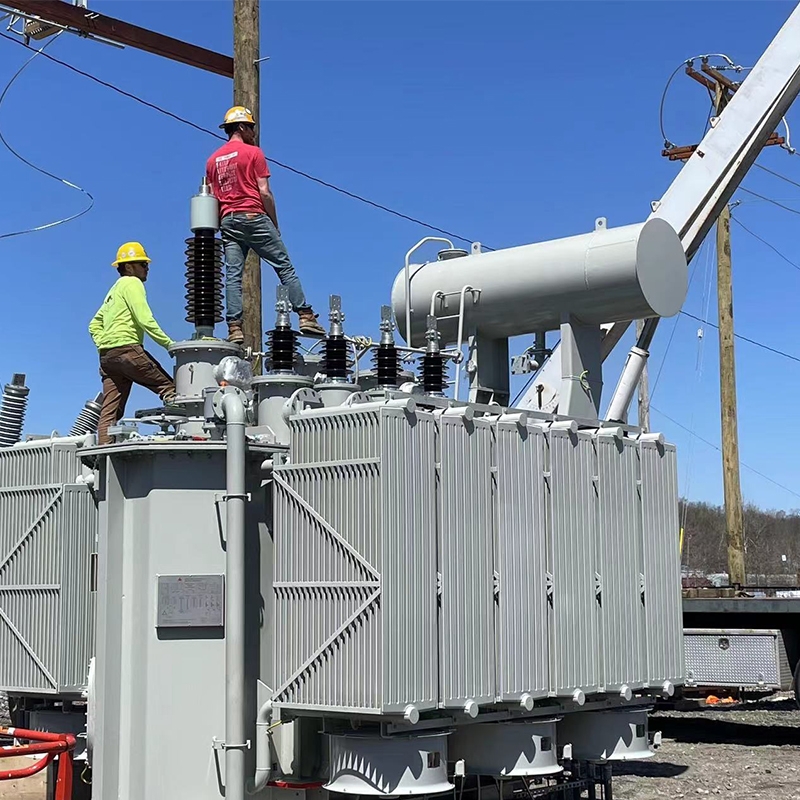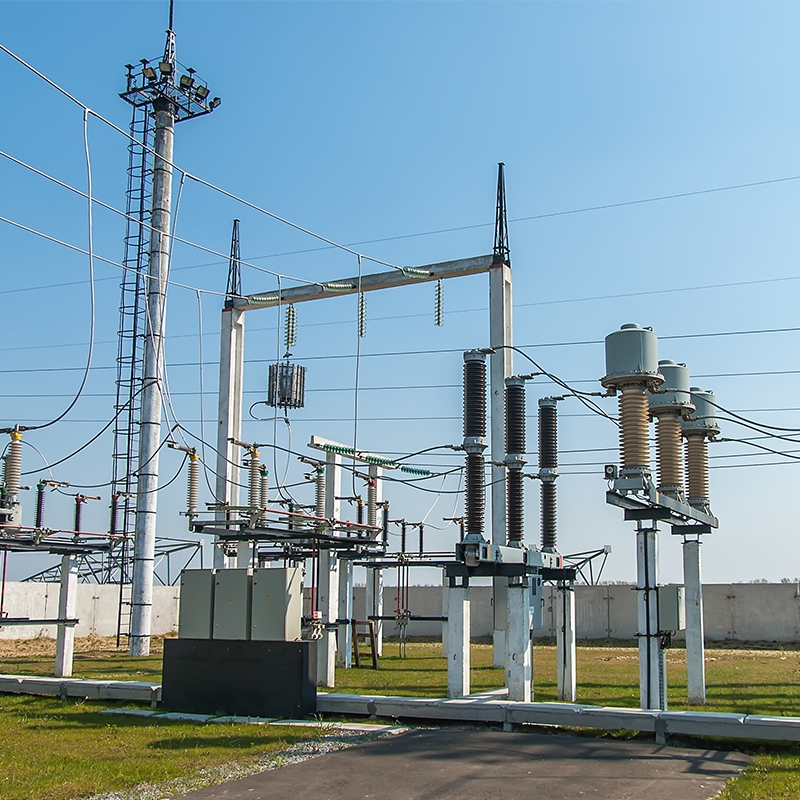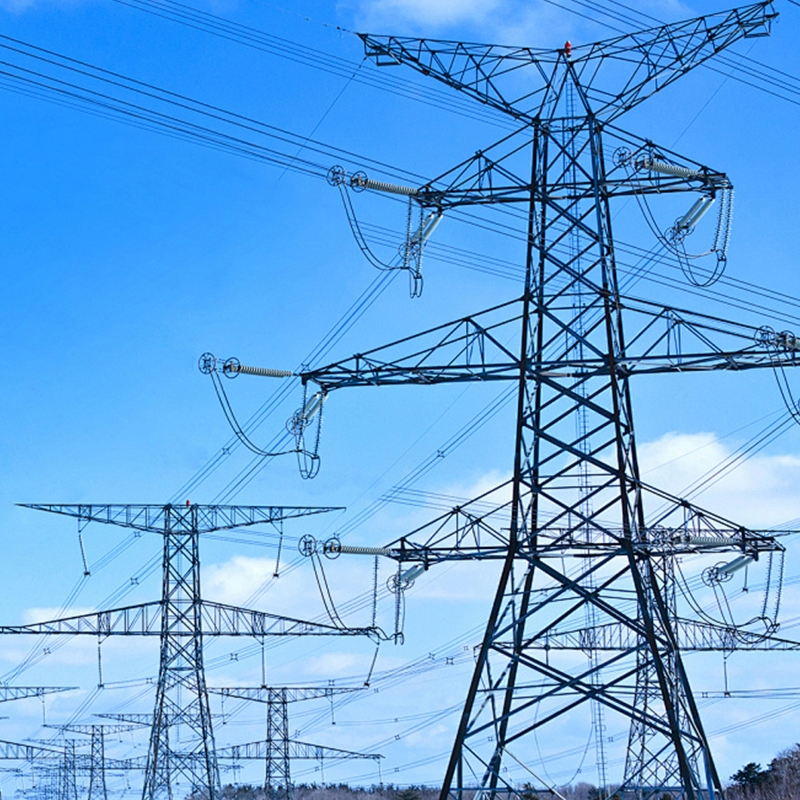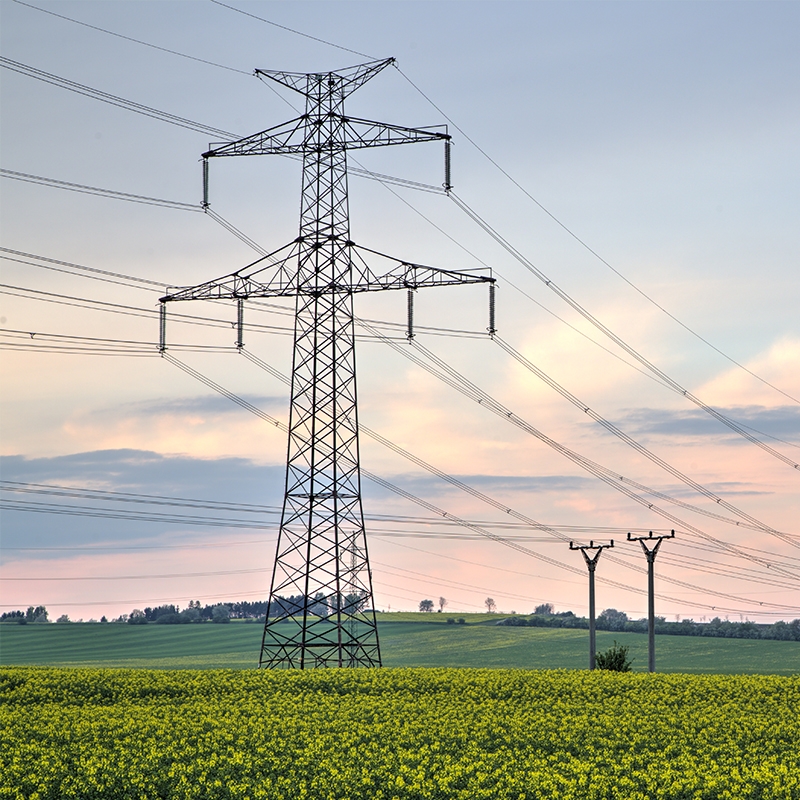Basic knowledge of power transformers
I. Classification and Models of Power Transformers
1. Classified by use
(1) Step-up transformer: Used in power plants to transmit electricity outward.
(2) Step-down transformer: It is used in substations of power supply bureaus for voltage transformation.
(3) Distribution transformer: It is used to supply power to users. (4) Plant transformer: It provides internal power for power plants.
(5) Station transformer: It provides internal power for the substation.
(6) Converter transformer: Used for DC transmission, one side is connected to AC power and the other side to the converter valve.
(7) Rectifier transformer: It is used to supply power to electrostatic precipitators in thermal power plants.
2. Classification by winding
(1) Double-winding transformer: used in step-up transformers, step-down transformers, plant transformers, etc.
(2) Three-winding transformer: used for step-down transformers, tie transformers, etc.
(3) Autotransformer: Used for step-down transformers, tie transformers, etc.
(4) Split transformers: There are two types, axial split and radial split, which are used for plant transformers and standby transformers.
3. Classification by structure
(1) Single-phase transformer: Used for transformers ranging from 330 to 1000kV.
(2) Three-phase transformer: Used for transformers ranging from 10 to 500 kV.
(3) Combined transformer: A transformer that is divided into several parts and then combined on site, used in areas with inconvenient transportation.
4. Classification by cooling method
(1) Oil-immersed transformer: Used for transformers ranging from 10 to 1000kV.
(2) Dry-type transformer: Used for transformers ranging from 10 to 110 kV.
(3) SF6 transformer: Currently used in 110 kV transformers.
5. Model of the power transformer
(1) The meanings of the letters in the model
D - Single-phase F - Oil-immersed air-cooled
O - Self-P - Forced oil circulation
S - Three-phase or three-coil; J - Oil-immersed self-cooling
Z - On-load voltage regulation L - Aluminum coil * Copper coil and double coil do not require symbols
(2) Examples
Sfpsl-120,000/110:110kV, 120MVA three-phase three-coil forced oil circulation air-cooled aluminum coil transformer
OSFPSZ - 240000/330:330 kV, 240MVA three-phase three-coil on-load voltage regulation forced oil circulation air-cooled autotransformer
Ii. Coils of power transformers
The coil is the most important and complex component in a power transformer. It is made by winding copper (or aluminum) wires and is composed of special insulating parts.
1. Spiral coil
The main feature of the helical coil is that it has a large number of parallel wires, the coil coils are wound in a helical shape, and one coil coil is one turn. Helical coils have good mechanical stability, excellent heat dissipation and good processability, and are widely used as low-voltage and high-current coils in transformers.
According to the magnitude of the current, the helical coil can be wound into three structures: single helical, double helical and four helical. 2. Continuous coil
When a coil is composed of several wire segments distributed along the axial direction and do not need to be welded to each other, it is called a continuous coil.
The end support surface of the continuous coil is large, it can withstand a large axial force, has strong short-circuit resistance, and each line segment has a large heat dissipation capacity. This kind of coil is widely used in both voltage levels and capacity ranges.
3. Tangled coil
The tangled coil is composed of several tangled line segments (cakes). A coil composed entirely of tangled segments (discs) is called a fully tangled coil and is widely used in transformers with voltages of 220kV and above. A coil composed of a part of the tangled line segments (pie) and a part of the continuous line segments is called a tangled continuous coil, which is applied to transformers with voltages of 66 kV and above.
Because it inserts non-adjacent turns between adjacent turns of the coil, it forms an interlaced tangled wire segment and constitutes a tangled coil, thereby increasing the longitudinal capacitance of the coil and improving the distribution characteristics of the impulse voltage along the axial height of the coil. Therefore, it has been widely used in various high-voltage coils.
4. Inner shielded coil
The inner shielded continuous coil achieves the purpose of improving the impulse voltage distribution by increasing the series capacitance between the line segments. Its structural feature is that the additional capacitor turns are directly wound inside the continuous wire segment. After the ends of the capacitor turns are insulated, they are suspended in the wire segment. The capacitor turns do not carry current and only function under impulse voltage.
The inner shielded continuous coil has structural forms such as two-segment crossover, four-segment crossover, eight-segment crossover and segmented connection.
Iii. Core of Power Transformer
The core is also an important component of power transformers. It is made by stacking highly magnetic silicon steel sheets and then clamping them with steel clamps or binding them with glass ribbons.
Silicon steel sheet
The silicon steel sheets used in power transformers are cold gadolinium silicon steel sheets with a thickness of 0.3 to 0.5mm. Currently, only Wuhan Iron and Steel Plant and Shanghai Baosteel in China can produce such cold gadolinium silicon steel sheets. However, the silicon steel sheets used for large transformers still have to be imported from Japan.
2. The structural form of the core
(1) Single-phase two-column core, used in various single-phase transformers.
(2) Single-phase section column yoke type core, used in high-voltage and large-capacity single-phase transformers.
(3) Single-phase two-column side yoke type core, used in high-voltage and ultra-high-voltage large-capacity single-phase transformers.
(4) Three-phase three-column is the core and is used in various three-phase transformers.
(5) Five-column core, used for large-capacity three-phase transformers.
Iv. Oil tank of Oil-immersed Transformer
1. Cylindrical oil tanks are mainly used for various small oil-immersed transformers and extra-large oil-immersed transformers.
2. Bell-shaped oil tanks are widely used in oil-immersed transformers ranging from 110 to 500kV.
3. Fully sealed oil tanks, which are welded together, have only been used in oil-immersed transformers of 110kV and above in recent years.
V. Oil storage tanks for oil-immersed Transformers
The oil storage tank of the transformer has two functions. One is to provide space for the thermal expansion and contraction of the transformer oil in the oil tank. Another measure is to separate the transformer oil from the external atmosphere to prevent it from aging.
1. Capsue-type oil storage tank, with rubber capsules inside to separate the transformer oil from the external atmosphere and provide space for the transformer oil to expand and contract due to temperature changes.
2. Diaphragm type oil storage tank, which uses rubber diaphragms to separate the transformer oil from the external atmosphere and provides space for the transformer oil to expand and contract due to temperature changes.
3. The corrugated oil storage tank uses a metal expander composed of metal corrugated plates to separate the transformer oil from the external atmosphere and provide space for the transformer oil to expand and contract due to temperature changes. Corrugated oil storage tanks are divided into two types: internal oil type and external oil type. The internal oil type has better performance, but it is larger in volume. Vi. Cooling Methods for Oil-Immersed Transformers
1. Symbols indicating cooling methods
The first letter: O - mineral oil, K - synthetic insulating liquid, L - insulating gas.
The second letter: N - Natural convection circulation, F - forced oil circulation, D - forced guided circulation.
The third letter: A - air, W - water.
The fourth letter: N - Natural convection, F - Forced circulation (fan, pump).
2. Examples
ONAN - Natural cooling
ONAF - Air cooling
OFAF - Forced oil circulation air cooling
ODAF - Forced Oil circulation guided cooling
Vii. Transformer bushing
Pure porcelain insulating bushings of 40kV and below
This kind of casing has two structures: the guide rod type and the cable threading type. The guide rod type is used for the low-voltage bushing of the transformer; The cable-threading type is used for high-voltage outgoing lines of 10 to 20kV.
2. High-current bushings of 40kV and below
This kind of casing has two structures: guide rod type and capacitive type. Guide rod type pure porcelain bushings are used for the low-voltage winding outgoing lines of medium-capacity generator transformers. Capacitive bushings are used for the low-voltage winding outgoing lines of large generator transformers. 3. 66kV and above oil-paper capacitive bushings
The inner insulation of this type of bushing is a capacitor core made by alternately winding insulating paper and aluminum foil. The space between the capacitor core and the porcelain bushing is filled with insulating oil. The connection between the bushing and the winding has two structures: guide rod type and cable type. The oil-paper capacitor core is made by alternately winding cable paper 0.08 to 0.12mm thick and aluminum foil 0.01mm thick on the conductive tube. 4. 66 kV and above adhesive tape capacitive bushings
The inner insulation of this type of sleeve is a capacitor core made by alternately winding adhesive paper and aluminum foil. The space between the capacitor core and the porcelain sleeve is filled with insulating oil, and the lower part of the sleeve does not require a porcelain sleeve. However, the tanδ of this kind of sleeve is large, and the adhesive paper is prone to cracking and causing partial discharge. Currently, production has been stopped.
5. Resin-cast capacitive bushings
The main insulation of this type of bushing is also a capacitor core made by alternately winding insulating paper and aluminum foil, and then epoxy resin is poured on the outside to form a solid insulating bushing. This kind of casing can be used as an oil-gas casing. The upper part is sleeved inside the pipeline of GIS, and SF6 gas is filled in between. The lower part is immersed in transformer oil.
Viii. Voltage Regulation Methods of Power Transformers
1. Pressure regulation method
There are two voltage regulation methods for transformers: no-excitation voltage regulation and on-load voltage regulation. No-excitation voltage regulation, also known as no-load voltage regulation, is carried out when the transformer is not in operation and does not carry a load. On-load voltage regulation is a voltage regulation operation carried out when the transformer is in operation and under load. A voltage regulating device without excitation voltage regulation is called a no-load tap changer. The device for on-load voltage regulation is called an on-load tap changer.
2. On-load voltage regulation position
There are three types of on-load voltage regulation positions for transformers: neutral point voltage regulation, medium-voltage line terminal voltage regulation, and high-voltage coil line terminal voltage regulation. Among them, the structure and process of neutral point voltage regulation are relatively simple, and it is also widely applied.
3. On-load voltage regulating switch
The voltage regulating switch is also a tap changer. At present, the quality of on-load tap changers produced domestically is not good enough. Most on-load tap changers rely on imports, among which there are more imports from MR In Germany and ABB in Sweden.
Ix. Transformer Oil
The composition of transformer oil
Transformer oil is a mineral oil. It is a mixture composed of many hydrocarbon molecules of different molecular weights, mainly consisting of alkanes, cycloalkanes and a small amount of aromatic hydrocarbons.
2. The function and grades of transformer oil
Transformer oil is used as the insulating oil for oil-immersed transformers. Transformer oil not only has an insulating function but also a heat dissipation function.
Transformer oil is classified into No. 25 oil and No. 45 oil based on its different freezing points. The freezing point of No. 25 oil is minus 25 degrees Celsius. The freezing point of No. 45 oil is minus 45 degrees Celsius.
Transformer oil No. 25 is paraffin-based oil, while transformer oil No. 45 is naphthenic base oil. In the past, No. 45 transformer oil had to be imported from abroad. Now, the refinery in Karamay, Xinjiang, can also produce it.
X. Manufacturing Process of Power Transformers
A power transformer is composed of two major parts: the transformer body and its accessories. The body of the device is composed of coils, insulating parts, cores, tap changers, transformer oil and oil tanks. The accessories of a transformer include an oil storage tank, cooler, bushing, gas relay, pressure relief device and thermometer, etc. Among them, the cooler, insulating oil, bushing, tap changer, gas relay, pressure relief device and thermometer, etc. are all purchased from outside. The manufacturing processes of several main components are only briefly introduced below.
1. Coil winding: Install the winding frame - Wind the coil - Weld the wire - wrap insulation - Shape the coil - test the coil.
2. Core assembly: Silicon steel sheet cutting - deburring - Stacking the core - installing the pull plate and shielding - binding the core - core testing - installing the core clamp.
3. Insulating part processing: Insulating part cutting - deburring - chamfering - moisture-proof treatment.
4. Processing of oil tanks and storage tanks: Steel plate cutting - welding of oil tanks and storage tanks - rust removal - sandblasting - application of primer - painting - mechanical strength test.
5. General assembly: Core installation - Oil tank pipeline installation - Coil set installation - Yoke stacking installation - Tap changer installation - Lead welding - Lead insulation wrapping - Semi-finished product test - Body drying - body organizing - oil tank assembly - Accessory assembly - oiling - sealing test - Hot oil circulation - Static placement. Xi. Factory tests of Power transformers
The factory tests of power transformers are divided into three types: routine (factory) tests, type tests and special tests. Routine tests are the test items that every transformer must undergo before leaving the factory, and they are usually also called factory tests. Type testing is a test item carried out by randomly testing 1 to 2 transformers in one type of product. Special tests are test items proposed by the user and agreed upon through consultation with the manufacturer.




